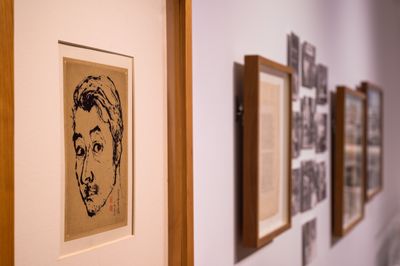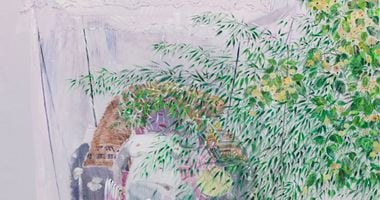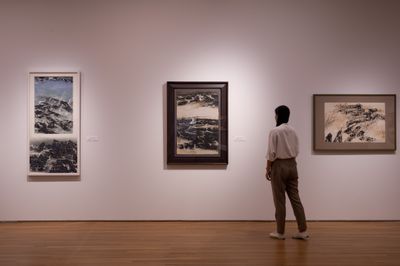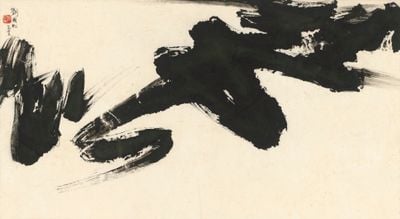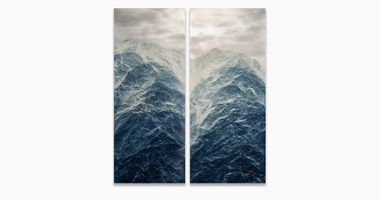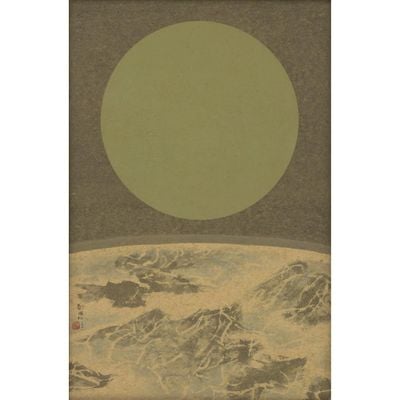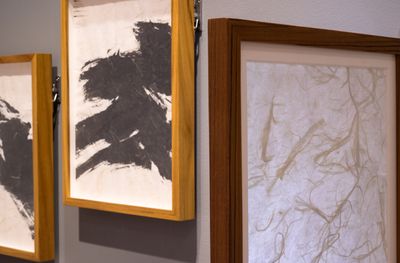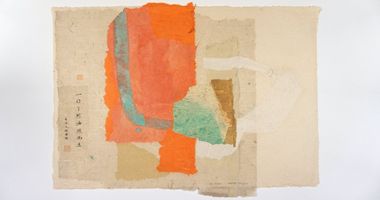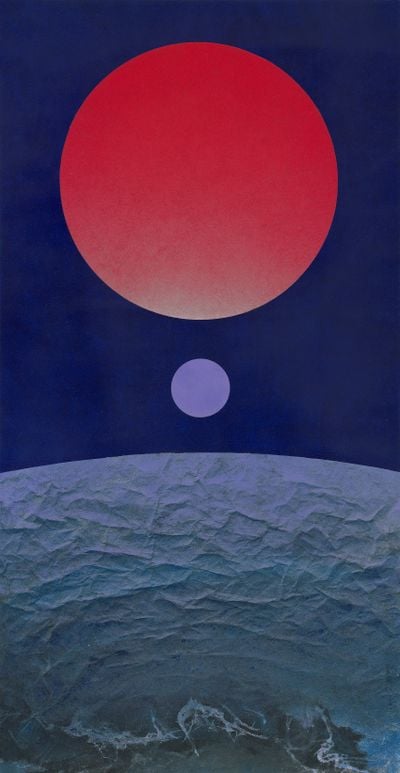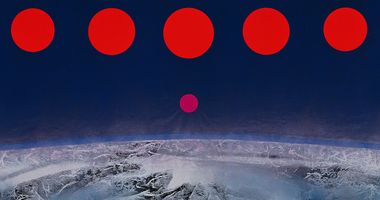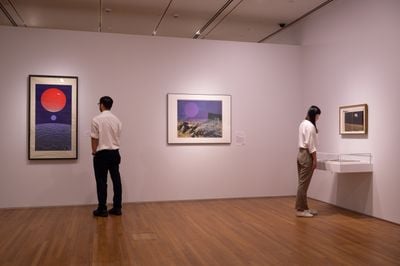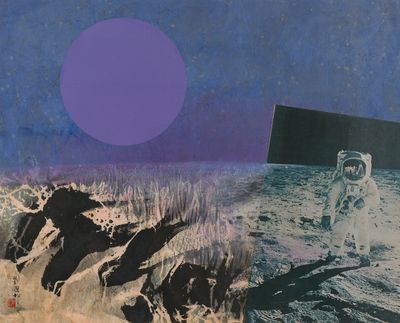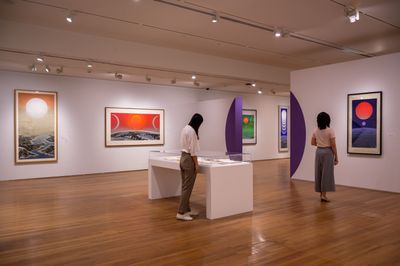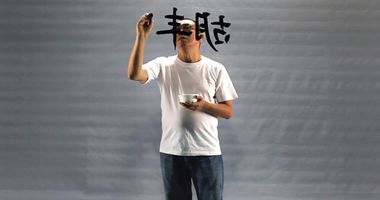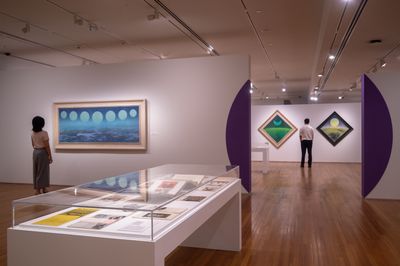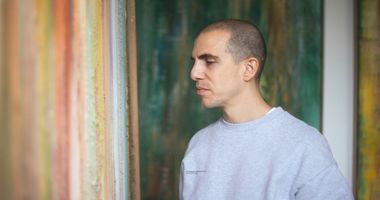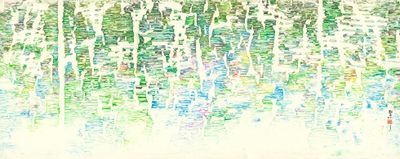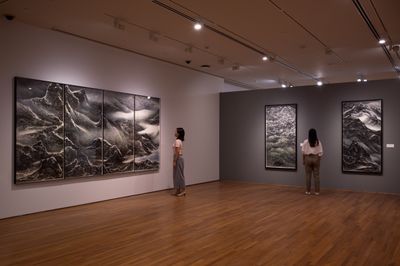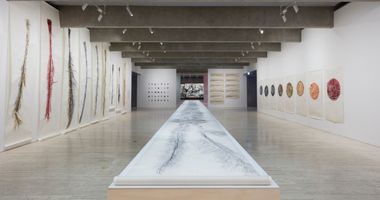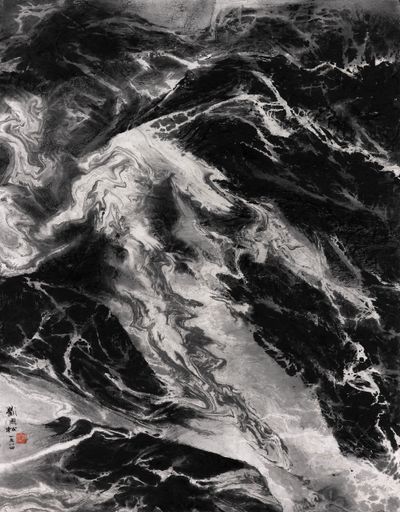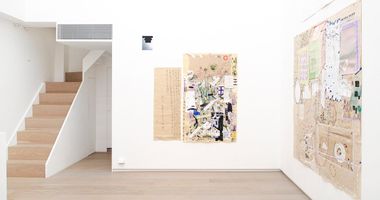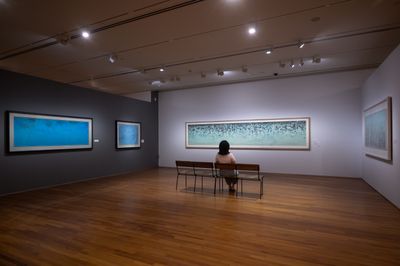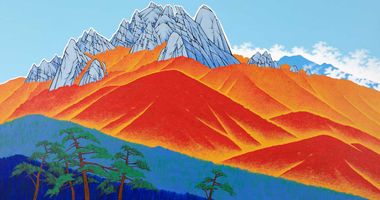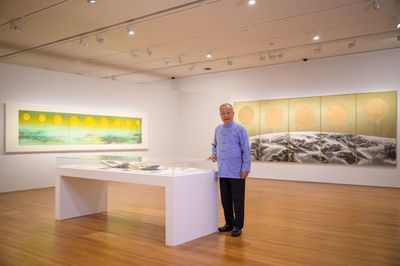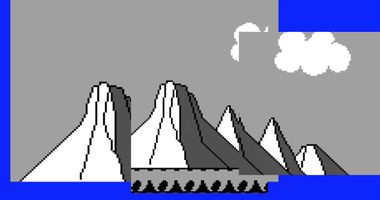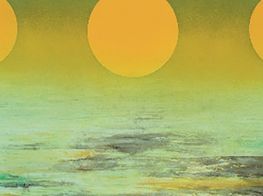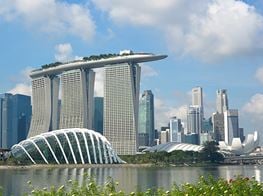Liu Kuo-sung: A Modern Master Who Found the Future in the Past
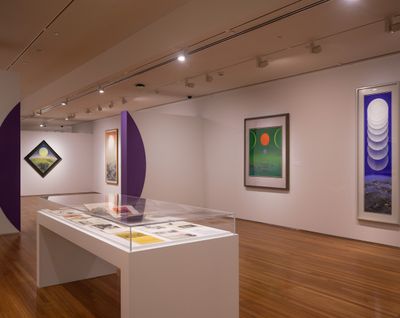
Exhibition view: Liu Kuo-sung: Experimentation as Method, National Gallery Singapore (13 January–26 November 2023). Courtesy National Gallery Singapore. Photo: Joseph Nair, Memphis West Pictures.
There have been a few moments in Liu Kuo-sung's life when his artistic direction took a decisive turn. Among them was his arrival at the fine arts department at National Taiwan Normal University, following his studentship at the Nanjing National Revolutionary Army Orphan School, which relocated to Taiwan in 1949.
Studying Chinese painting under Pu Hsin-Yu and Huang Junbi and Western painting under Liao Chi-Chun, who encouraged Liu's artistic tenacity, and Chu Teh-Chun, who was renowned for merging Eastern and Western techniques, Liu soon established himself as a rebel with a cause.
In his second year, he abandoned Chinese painting, believing Western painting—and Abstract Expressionism, in particular—to be more representative of life than the rote forms of repetition he encountered in his ink-and-brush training.
In 1956, the year he graduated, Liu co-founded the Fifth Moon Group to create a space for modernism that was untethered to the traditionalist demands of state-sponsored nationalism in Taiwan, and engaged with artistic developments in the Western world.
As Liu began exploring the synergies between East and West, concluding that artists strove for freedom no matter where they came from, he realised that he need only look to Chinese art history to seek out the radicalism he admired in the Western avantgarde.
He learned that some of Abstract Expressionism's leading figures—Jackson Pollock, Franz Kline, Antoni Tapies, and Cy Twombly—had been deeply influenced by the calligraphic lines of ink art, with Mark Tobey in particular studying Chinese calligraphy in the 1930s.
With that in mind, Liu Kuo-sung: Experimentation as Method at the National Gallery Singapore (13 January–26 November 2023), opens with a work that marked a seismic shift in Liu's artistic path.
Dance of the Black Ink, created in 1963, represents a rediscovery of ink's capacity for expression. A thick, black brushstroke ripples from the left side of the paper like a filament, until a staccato pause is marked by a short gap where the brush was lifted.
Invoking the feibai (flying white) technique that speaks to the negative spaces created by intentional yet spontaneous strokes, the line soon picks up with a snaking curl that transitions into a series of jagged oscillations moving towards the top-right corner.
The painting's title speaks to Liu's engagement with kuangcao, which literally translates to 'mad grass', referring to an expressive cursive script in Chinese calligraphy that matured in the Tang dynasty.
By the time Liu made this work, he had come face-to-face with ancient Chinese ink painting for the first time. In 1961, he was struck by Northern Song dynasty painter Fan Kuan's monumental landscape, Travelers Amid Mountains and Streams, which he saw in the National Palace Museum's collection in Taipei.
There, he later encountered a publication depicting Southern Song dynasty painter Liang Kai's Immortal in Splashed Ink, which the artist apparently painted while drunk, using broad, free-form strokes with minimal definition.
From these encounters, Liu understood the interplay between East and West, and indeed the concepts of abstraction, figuration, and minimalism, was more than a one-sided narrative.
By his estimation, Chinese painting had preceded Expressionism—whether in Europe or the United States—by centuries. Yet, in the 20th century, he observed, it was the Abstract Expressionists who pushed the legacy of ink into the future. So Liu reversed focus and turned to history to inform his desire to modernise his craft.
What followed was Liu's iconic space paintings, which perfectly balanced the two artistic poles between which he had trained: a response to the 1968 Apollo 8 mission that yielded Earthrise, an iconic colour photograph of the world viewed beyond the surface of the moon.
Moved by the magnitude of this planetary vision, Liu created Which is Earth? (1969). The mixed-media scroll depicts a large, solitary circle containing a tempest of broad ink strokes, which hovers over the moon's curved landscape rendered with equally exuberant marks below.
Now part of the Phoenix Art Museum collection, Which is Earth? is the first in Liu's Space paintings, which connect the tenets of shan shui painting (literally: 'mountain water')—and its abstraction of an earthly totality through the depiction of natural landscapes—with the 20th-century's planetary awakening.
At National Gallery Singapore, Which is Earth? No. 2 (1969) is presented alongside a January 1969 LIFE magazine cover showing a colour image of earth alongside a double-page spread of the Earthrise photograph.
Completing this historic presentation is Moon Walk, which Liu created in 1969 to commemorate Buzz Aldrin's iconic leap for mankind. Liu pasted the image of the Apollo 11 astronaut's moon walk onto a painting whose black marks and white contours build a landscape that perfectly matches its source image, as a large purple orb holds court over a gradated violet sky.
It is perhaps Liu's appreciation of change that best describes his unceasing journey into ink painting's future.
Considering the striking contrasts between colours, textures, and shapes that tapped into the currents of Pop art and hard-edge abstraction at the time, Liu's cosmic ink works, which often employ collage to create sharper delineations between circle and gradated ground, were revelatory.
The diamond-shaped ink-on-paper Green Moon (1972), for instance, features a forest green sky from which a chrysoprase crescent hangs like a cradle over a curved lime plane; while Red Sun (2015) shows a solid ruby circle at the centre of a turquoise ground that undulates with subtle grey ink swirls.
Throughout the decades, Liu's space paintings grew into multi-panel compositions with phases of the moon, sun, or earth, rendered as cycles. BRICS (2017), for instance, shows five gold suns forming a cyclical curve over a golden, umber sky that meets the rounded edge of a land mass rendered in characteristic textures of black and white.
These paintings combine several techniques that Liu pioneered in the 1960s—among them, the invention of his coarse paper in 1963, typified by a fibre-rich top layer. Liu paints this paper with black ink before pulling at its seams to create negative white 'strokes', resulting in compositions that are infused with the sculptural volume of a natural terrain.
Other techniques can be seen in works like Revolving Moon (2015), where seven pastel blue moons curve in a line across a sky that moves from dark to light cerulean, before meeting a liquid-like ground that fades into a blurred horizon, creating the impression of an aerial view.
That fluid effect has its own showcase in Experimentation as Method, in a section focusing on paintings that emulate bodies of water, notably the jewel-toned lakes of the UNESCO heritage site, Jiuzhaigou National Park. Liu visited this network of valleys in Sichuan province that form part of the Min Mountains range, linking the Tibetan Plateau and Sichuan Basin, in the early 2000s, and resolved to find a way to articulate its ineffable grandeur.
In the Midst of a Beautiful Spring (2008) is a large, landscape-format work on paper whose emerald, sapphire, and garnet tones mingle in intricate ripples, their edges forming rich internal bleeds that convalesce around cleanly delineated negative spaces that open out to a downward fade.
The painting was created with a technique that drew from Liu's time as a teaching assistant in the architecture department at Tainan Cheng Kung University—an appointment he received in 1959 after being rejected by, according to his account, all the art departments in Taiwan due to his antagonistic stance towards the teaching of Chinese painting.
Struck by the department's debates surrounding the use of reinforced cement to imitate dougong—an interlocking way of building without screws, glue, or nails—and the idea that one must stay true to the essence of materials, Liu questioned his use of oil paint to achieve the fluidity of ink wash.
Beyond inventing his own paper, which built on early oil experiments involving canvases primed with plaster to create texture and volume, Liu began experimenting with architectural tracing paper, which he utilised to create his Jiuzhaigou works. What emerged was a form of mono-printing, where ink and watercolour are applied to a moist sheet before brushing another sheet on top, or painting a top sheet that bleeds into a sheet below.
Liu's printing yields unique patterns, with air pockets and presses creating soft bubbles and swirls. In Cold Night in Shanghai (2010), wisps of grey-scale ink circulate over a flat, swimming-pool blue.
Earlier experiments with water rubbing produced other impressions of fluidity. By pressing paper into ink compositions created in water, Liu produced breathtaking abstractions that tap into the naturally expressive spontaneity of liquid.
Liu developed this form of marbling after arriving in Hong Kong, where he was appointed Chairman of the Fine Arts Department at the Chinese University in 1972. He became a leading figure in Hong Kong's New Ink Painting movement, introducing the first-ever curriculum for modern ink painting, which explored Eastern and Western techniques, art histories, and critical theories.
Liu understood the interplay between East and West, and indeed the concepts of abstraction, figuration, and minimalism, as more than a one-sided narrative.
In Hong Kong, Liu taught his students to 'be different first, develop [their] own style and ... perfect it later. Then the world is very open.'1 While that openness defines Liu's innovative spirit, it likewise anchors his practice to the heart of shan shui painting: to express the world's profound natural beauty through the depiction of its landscapes as all-encompassing physical and emotional experiences.
That essence is most palpable in the final section of Liu's exhibition in Singapore, titled 'Lying Down on Water, Mountains Rising and Falling', which features large-scale paintings created following a visit to Mount Everest in 2000, at the age of 68.
Moved by the views he encountered, Liu did not notice the two-and-a-half hours spent at high altitude. The experience cost him the hearing in his left ear; the acceptance of which seems to feed into sweeping landscapes awash with white mists that recall the rapid fluctuations between light and dark he witnessed at the top of the world.
'I really experienced what the realm of forgetfulness was like,' Liu recalled during a talk at National Gallery Singapore in 2018.2 'The clouds kept moving, the mountain kept changing, and it was so beautiful.'
Now a lucid and upright nonagenarian who speaks emphatically about a practice that has never stopped evolving—many works in Experimentation as Method were painted as recently as 2020—it is perhaps Liu's appreciation of change that best describes his unceasing journey into ink painting's future.
That journey recalls artist aaajiao's assertion that contemporary China lacks a prevailing theory of modernity, resulting in a fetishisation of Sinofuturism. The term refers to the enmeshment of technology and culture in 21st-century China, which artist and writer Gary Zhexi Zhang describes as an idea that 'orbits around a Euro-American planet'.3
'What is at stake in Sinofuturism—as a dream, a nightmare or an impending reality—is not only the decentring of Euro-American cultural hegemony, but also the narrative of futurity as a historical (modern) aesthetic,' Zhang writes. It is a narrative that Liu Kuo-sung reclaimed decades ago. —[O]
1 Andrew Dembina, 'Ink Artist Liu Kuo Sung fuses East and West', Prestige, 18 May 2017.
2 Liu Kuo-sung and Cai Heng, 'New Moons, Liu Kuo-Sung', Youtube, National Gallery Singapore, 8 September 2018.
3 Gary Zhexi Zhang, 'Where Next? Imagining the Dawn of the "Chinese century"', Frieze, 22 April 2017.

